Research Contribution of the Oldest Seat of Higher Learning in Pakistan: A Bibliometric Analysis of University of the Punjab
Abstract
1. Introduction and Historical Background
- What is the university’s research output in terms of research publications during its 137 years’ life?
- What is the impact of this research in terms of citations in PU publications by other researchers?
- What are the frequently publishing subject areas of PU researchers?
- Which are the preferred journals PU researchers prefer to publish their research?
- How different is the impact of research on open access and subscription-based journals?
- What is the relative research position of PU in similar/peer universities?
2. Literature Review
3. Methods
- The selected university should be from the “public” sector.
- The selected university should be registered in the “general” category of subjects and fields.
- The selected university should be situated in other provinces/states of the country.
- The selected university should be governed by a similar provincial/state administration and has similar funding sources.
- The non-Pakistani university selected for comparison must have been established in the same period by the same British rulers as the University of Punjab.
- University of Karachi (KU)
- University of Baluchistan (BU)
- University of Peshawar (UP)
- University of Allahabad (AU)
4. Limitations:
- Data for this study are limited to the Scopus database only.
- Actual citation count is extracted from Scopus.
- Although the Scopus claims to be one of the largest databases of peer-reviewed literature, however, it does not index all the published resources due to its indexing policy. Therefore, the study may have missed the documents that are not indexed in Scopus. The comparatively low indexing coverage of books database can be the limitation.
- A portion of research in Pakistan is published in Urdu, the national language of the country. The scholarly literature published in Urdu and other regional languages is not covered.
- Various researchers have argued against the citation count method for research evaluation. A document has been cited highlighting drawbacks in that particular study. Hence, citations cannot be presumed as the indicator of the quality solely and in all the cases. For this, the adopted citation analysis method is not failsafe. Furthermore, the raw citation counts might be misleading due to differences in field and time, whereas normalized citation scores often yield a better proxy for the paper quality.
5. Data Analysis
- The volume and growth of the research publications
- Research place of PU in the studied universities
- Researchers’ access preference and document types of publishing their research
- Subject strengths of the universities concerning research output
- The qualitative part contains detailed analysis on:
- Measuring research impact through citations analysis
- Collaboration patterns assessment of the research output
- Nobel laureates produced by the peer universities
- Research Output and Share of PU
- A sharp increase is observed in the research output of PU and other Pakistani universities at the beginning of the 21st century. In PU’s 137 historical years, around 92% of its total publications are in the first 20 years of this century. The case is almost similar to other peer universities of Pakistan. On average, 89% of the total publications of compared Pakistani universities are published in the past 20 years. The case of AU, the other peer university form India is slightly different, with 60% of its publications published in the 21st century. The growth in the research productivity of PU and other Pakistani universities in 21st century could be attributed to the availability of ICT, the establishment of HEC in 2002 and universities’ vision for the better regional, national and international rankings as indicated by [42]. Indeed, HEC marked a phenomenal impact in the higher education and research output of Pakistani Universities. Figure 1 shows the year wise productivity of PU and peer universities. The figures represent publication data from the year 1974 till 2019.
- The slow progress in research is observed during the British period and in the early decades after the independence for PU and AU. Researchers are critical to the system of education based on which these universities were established by the British rulers. Universities lacked financial resources to conduct quality research and attract the best minds. The universities were mainly focusing on teaching activities rather than research [46]. Howell [47] stated the condition of education in India during the British rule, “Education in India under the British government was first ignored, then violently and successfully opposed, then conducted on a system now universally admitted to be erroneous and finally placed on its present footing”. Retaining these characteristics by Pakistani universities resulted in the lack of quality research [48]. This culture impacted the universities even after the British left the sub-continent. The University of the Punjab was not an exception, and it inherited weak research culture.
6. Collaboration Patterns
6.1. Nobel Laureates
6.2. Authorship Patterns
7. Impact Analysis
Funding Agencies
8. Discussion and Recommendations
- The significant growth in research publications in PU and other peer Pakistani universities is attributed to the educational reforms and the establishment of HEC at the beginning of the 21st century. The HEC’s initiatives like the consortium-based subscription to online research databases through the National Digital Library Program Pakistan, Education and Research Network and National Research Programs has significantly supported the researchers and the universities to do research. This study highly recommends the continuity of such initiatives. The study also recommends the appropriate funds should be allocated to HEC for the sustainability of the research enterprise of the country.
- The findings of this study showed the direct relationship between the level of collaboration and the number of citations. Higher author collaboration leads to higher citations. Therefore, this research recommends that higher collaborative approach in the research endeavors is encouraged.
Author Contributions
Funding
Acknowledgments
Conflicts of Interest
Availability of Data and Material
References
- Carnegie Foundation for the Advancement of Teaching. The Carnegie Classification of Institutions of Higher Education; Carnegie Foundation for the Advancement of Teaching: Menlo Park, CA, USA, 2001. [Google Scholar]
- Rahman, T. Education in Pakistan: A survey-google books. In Pakistan on the Brink: Politics, Economics, and Society; Baxter, C., Ed.; Lexington Books: Lanham, MD, USA, 2004; p. 171. [Google Scholar]
- Radhakrishnan, P. Indigenous Education in British India: A Profile. Contrib. Indian Sociol. 1990, 24, 1–27. [Google Scholar] [CrossRef]
- Leitner, G.W. History of Indigenous Education in The Punjab Since Annexation and In 1882; Languages Dept., Panjab; University of Montana: Missoula, MT, USA, 1883. [Google Scholar]
- Mayhew, A. A Comparative survey of educational aims and methods in British India and British Tropical Africa. Afr. J. Int. Afr. Inst. 1933, 6, 15. [Google Scholar] [CrossRef]
- Basu, A. Indian Education in Parliamentary Papers; Asia Publishing House: Mumbai, India, 1952. [Google Scholar]
- Mahmood, E.; Akhtar, M.S.; Butt, I.H. A critical review of the evolution of higher education in Pakistan. J. Educ. Res. 2015, 18, 57–75. [Google Scholar]
- University of the Punjab-Introduction. Available online: http://pu.edu.pk/page (accessed on 7 January 2019).
- University of the Punjab. Fact Book 2018; University of the Punjab: Lahore, Pujab, 2019. [Google Scholar]
- Javed, S.A.; Liu, S. Predicting the research output/growth of selected countries: Application of even GM (1, 1) and NDGM models. Scientometrics 2018, 115, 395–413. [Google Scholar] [CrossRef]
- Abbot, M.; Doucouliagos, H. Research output of Australian Universities. Educ. Econ. 2004, 12, 251–265. [Google Scholar] [CrossRef]
- Goodall, A.H. Highly cited leaders and the performance of research Universities. Res. Policy 2009, 38, 1079–1092. [Google Scholar] [CrossRef]
- Coccia, M. A scientometric model for the assessment of scientific research performance within public institutes. Scientometrics 2005, 65, 307–321. [Google Scholar] [CrossRef]
- Rodríguez-Navarro, A. Measuring research excellence: Number of Nobel prize achievements versus conventional bibliometric indicators. J. Doc. 2011, 67, 582–600. [Google Scholar] [CrossRef]
- Garousi, V.; Mäntylä, M.V. Citations, research topics and active countries in software engineering: A bibliometrics study. Comput. Sci. Rev. 2016, 19, 56–77. [Google Scholar] [CrossRef]
- Tang, Y.; Ren, Z.; Kong, W.; Jiang, H. Compiler testing: A systematic literature analysis. Front. Comput. Sci. 2020, 14, 1–20. [Google Scholar] [CrossRef]
- Ramírez, M.C.; Armando, R.; Devesa, R. A Scientometric Look on Mathematics Education from Scopus Database. Math Enthus. 2019, 16, 37–46. [Google Scholar]
- Beydoun, G.; Abedin, B.; Merigó, J.M.; Vera, M. Twenty years of information systems frontiers. Inf. Syst. Front. 2019, 21, 485–494. [Google Scholar] [CrossRef]
- Khan, A.; Choudhury, N.; Uddin, S.; Hossain, L.; Baur, L.A. Longitudinal trends in global obesity research and collaboration: A review using bibliometric metadata. Obes. Rev. 2016, 17, 377–385. [Google Scholar] [CrossRef] [PubMed]
- Alvarez, P.; Pulgarin, A. The rasch model. Measuring the impact of scientific journals: Analytical chemistry. J. Am. Soc. Inf. Sci. 1996, 47, 458–467. [Google Scholar] [CrossRef]
- Chuang, K.-Y.; Olaiya, M.T.; Ho, Y.-S. Bibliometric analysis of the Polish journal of environmental studies (2000–2011). Polish J. Environ. Stud. 2012, 21, 1175–1183. [Google Scholar]
- Donthu, N.; Kumar, S.; Pattnaik, D. Forty-five years of journal of business research: A bibliometric Analysis. J. Bus. Res. 2020, 109, 1–14. [Google Scholar] [CrossRef]
- Ezema, I.J.; Onyancha, O.B. A bibliometric analysis of health and medical journals: Issues in medical scholarly communication in Africa. Ser. Rev. 2016, 42, 116–128. [Google Scholar] [CrossRef]
- Xu, Z.; Zhou, W.; Baltrėnaitė, E. Comprehensive bibliometric study of journal of environmental engineering and landscape management form 2007 to 2019. J. Environ. Eng. Landsc. Manag. 2019, 27, 215–227. [Google Scholar] [CrossRef]
- Darmadji, A.; Prasojo, L.D.; Kusumaningrum, F.A.; Andriansyah, Y. Research productivity and international collaboration of top Indonesian Universities. Curr. Sci. 2018, 115, 653–658. [Google Scholar] [CrossRef]
- Gumpenberger, C.; Sorz, J.; Wieland, M.; Gorraiz, J. Humanities and social sciences in the bibliometric spotlight–Research output analysis at the University of Vienna and considerations for increasing visibility. Res. Eval. 2016, 25, 271–278. [Google Scholar] [CrossRef]
- García, J.A.; Rodríguez-Sánchez, R.; Fdez-Valdivia, J.; Robinson-García, N.; Torres-Salinas, D. Mapping academic institutions according to their journal publication profile: Spanish Universities as a case study. J. Am. Soc. Inf. Sci. Technol. 2012, 63, 2328–2340. [Google Scholar] [CrossRef]
- Javed, Y.; Ahmad, S.; Khahro, S.H. Evaluating the research performance of islamabad-based higher rducation institutes. SAGE Open 2020, 10, 2158244020902085. [Google Scholar] [CrossRef]
- Qayyum, M.; Naseer, M.M. Bio-Bibliometric Study of Dr. Khalid Mahmood’s Contributions to LIS Field in Pakistan. Library Philosophy and Practice. 2013. Available online: http://hdl.handle.net/10760/18994 (accessed on 25 August 2020).
- Kousar, M.; Mahmood, K. Dr. Syed Jalaludin Haider: A Bio-Bibliometric Study. Pakistan Journal of Information Management and Libraries. 2010. Available online: http://hdl.handle.net/10760/25605 (accessed on 25 August 2020).
- Hou, D.; Bi, X.; Mao, Z.; Fan, Y.; Hu, X.; Li, X. Biomaterials research of china from 2013 to 2017 based on bibliometrics and visualization analysis. PeerJ Bioinform. Genom. 2019, 7, e6859. [Google Scholar] [CrossRef] [PubMed]
- Mahbuba, D.; Rousseau, R. Scientific research in the Indian subcontinent: Selected trends and indicators 1973–2007 comparing Bangladesh, Pakistan and Sri Lanka with India, the local giant. Scientometrics 2010, 84, 403–420. [Google Scholar] [CrossRef]
- Srivastav, A.L.; Kaur, T.; Rani, L.; Kumar, A. Scientific research production of India and China in environmental chemistry: A bibliometric assessment. Int. J. Environ. Sci. Technol. 2019, 16, 4989–4996. [Google Scholar] [CrossRef]
- Mehar, S.M.; Chikhaoui, E.; Javed, Y.; Ahmad, S. Rohingya crises: Mapping the peer-reviewed literature. Int. J. Innov. Creat. Chang. 2019, 7, 186–199. [Google Scholar]
- Sweileh, W.M. Bibliometric analysis of peer-reviewed literature on Syrian refugees and displaced people (2011–2017). Confl. Health 2018, 12, 43. [Google Scholar] [CrossRef]
- Baladi, Z.; Umedani, L.V. Pakistan journal of medical sciences: A bibliometric assessment 2001–2010. Pakistan J. Med. Sci. 2017, 33, 714–719. [Google Scholar]
- Jan, S.U. Collaborative research in economics in Pakistan: The case of Pakistan development review from 1973 to 2009. Libr. Philos. Pract. 2017, 1, 171–181. [Google Scholar]
- Anwar, M.A.; Saeed, H. Pakistani librarians as authors: A bibliometric study of citations in LISA-PLUS. Asian Libr. 1999, 8, 39–46. [Google Scholar] [CrossRef]
- Naseer, M.M.; Mahmood, K. Use of Bibliometrics in LIS Research. LIBRES Libr. Inf. Sci. Res. Electron. J. 2009, 19, 1. [Google Scholar]
- Warraich, N.F.; Ahmad, S. Pakistan journal of library and information science: A bibliometric analysis. Pakistan J. Libr. Inf. Sci. 2011, 12, 1. [Google Scholar]
- Mushtaq, A.; Abid, M.; Qureshi, M.A. Assessment of research output at higher level of educaton in Pakistan. J. Pak. Med. Assoc. 2012, 62, 628–632. [Google Scholar] [CrossRef] [PubMed]
- Warriach, N.F.; Tahira, M. Impact of information and communication technologies on research development: A case of University of the Punjab-Pakistan. Pakistan J. Inf. Manag. Libr. 2014, 15, 47–53. [Google Scholar]
- Warraich, N.F.; Ameen, K. Perceptions of LIS professionals regarding use of Pakistan national digital library databases. Electron. Libr. 2010, 28, 108–121. [Google Scholar] [CrossRef]
- Baas, J.; Schotten, M.; Plume, A.; Côté, G.; Karimi, R. Scopus as a curated, high-quality bibliometric data source for academic research in quantitative science studies. Quant. Sci. Stud. 2020, 1, 377–386. [Google Scholar] [CrossRef]
- Visser, M.; van Eck, N.J.; Waltman, L. Large-scale comparison of bibliographic data sources: Scopus, web of science, dimensions, crossref, and Microsoft academic. In Proceedings of the 17th International Conference on Scientometrics and Informetrics ISSI 2019, Rome, Italy, 2–5 September 2019. [Google Scholar]
- Shils, E. The academic profession in India. In Elites in South Asia; Leach, E., Mukherjee, S.N., Eds.; Cambridge University Press: Cambridge, UK, 1970; pp. 172–200. [Google Scholar]
- Howell, A. Education in British India, Prior to 1854, and in 1870–71; Office of the Superintendent of Government Printing: Calcutta, India, 1872.
- Rahman, T. Language, Education, and Culture; Oxford University Press: Karachi, Pakistan, 1999. [Google Scholar]
- Charlton, B.G. Measuring revolutionary science 1992–2006 using Nobel prizes, Lasker (clinical medicine) awards and Gairdner awards (NLG Metric). Med. Hypotheses 2007, 69, 1–5. [Google Scholar] [CrossRef]
- Shelton, R.D.; Holdridge, G.M. The US-EU Race for Leadership of Science and Technology: Qualitative and Quantitative Indicators; Kluwer Academic Publishers: Dordrecht, The Netherlands, 2004; Volume 60. [Google Scholar]
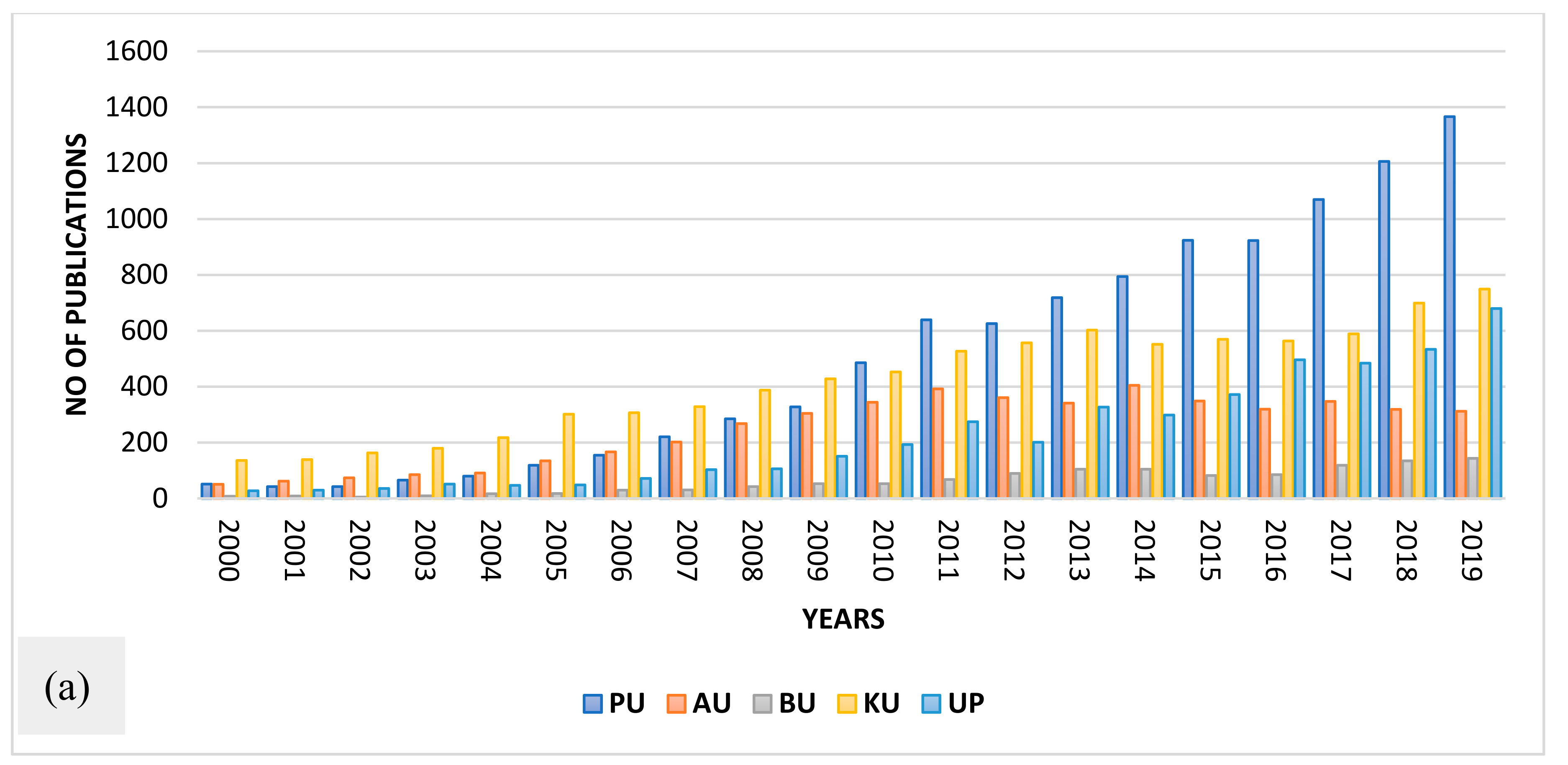
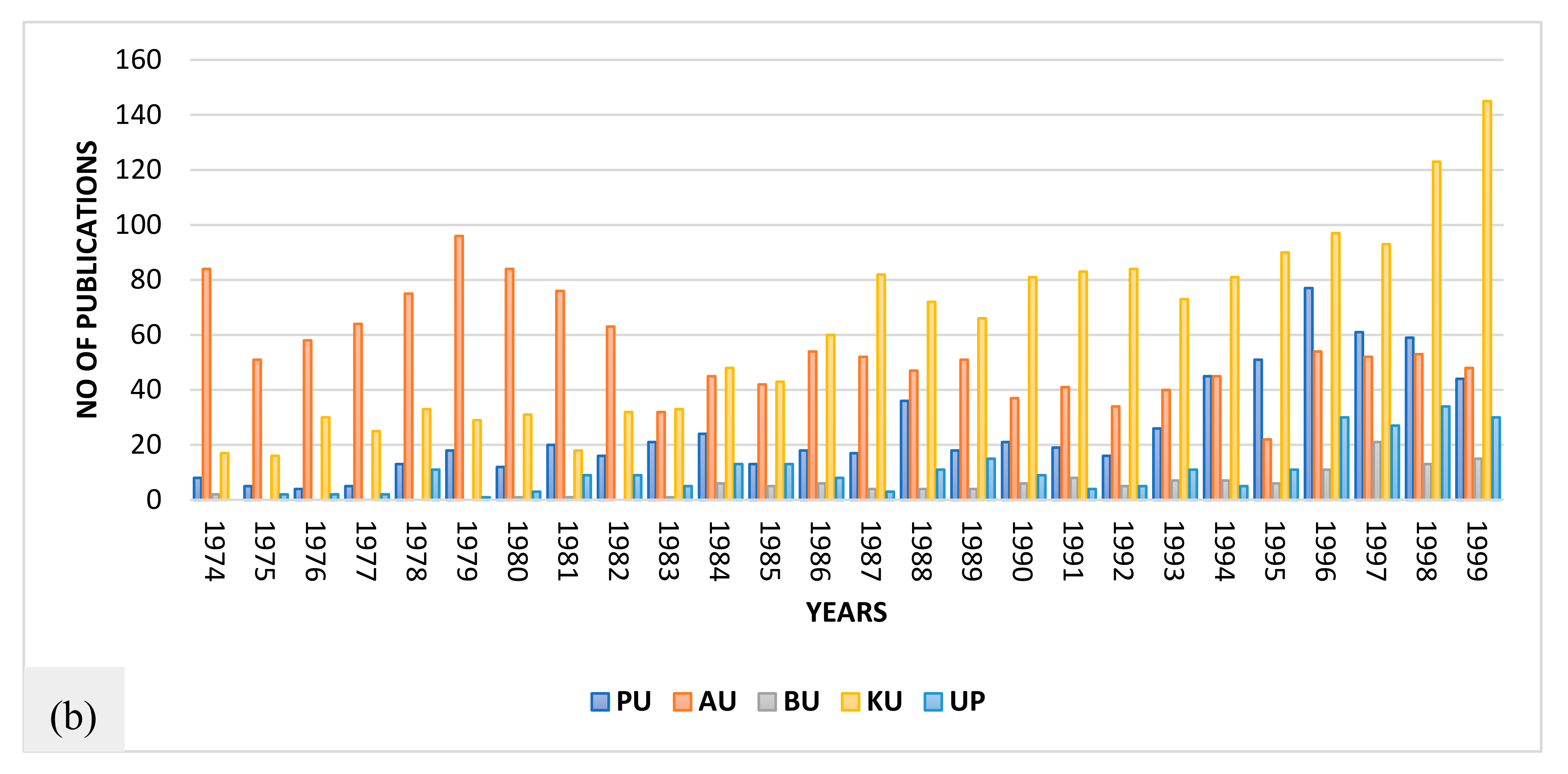
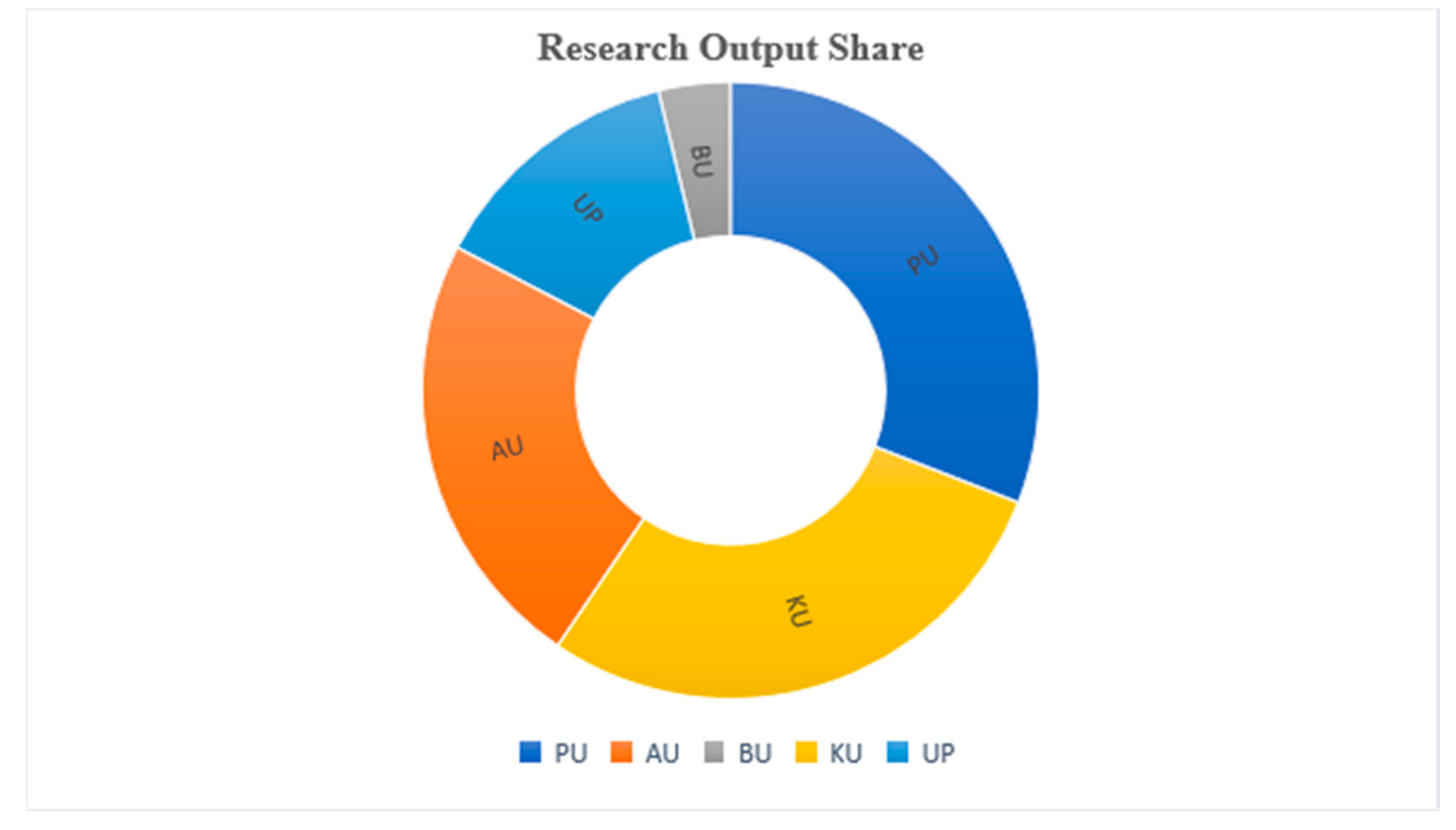
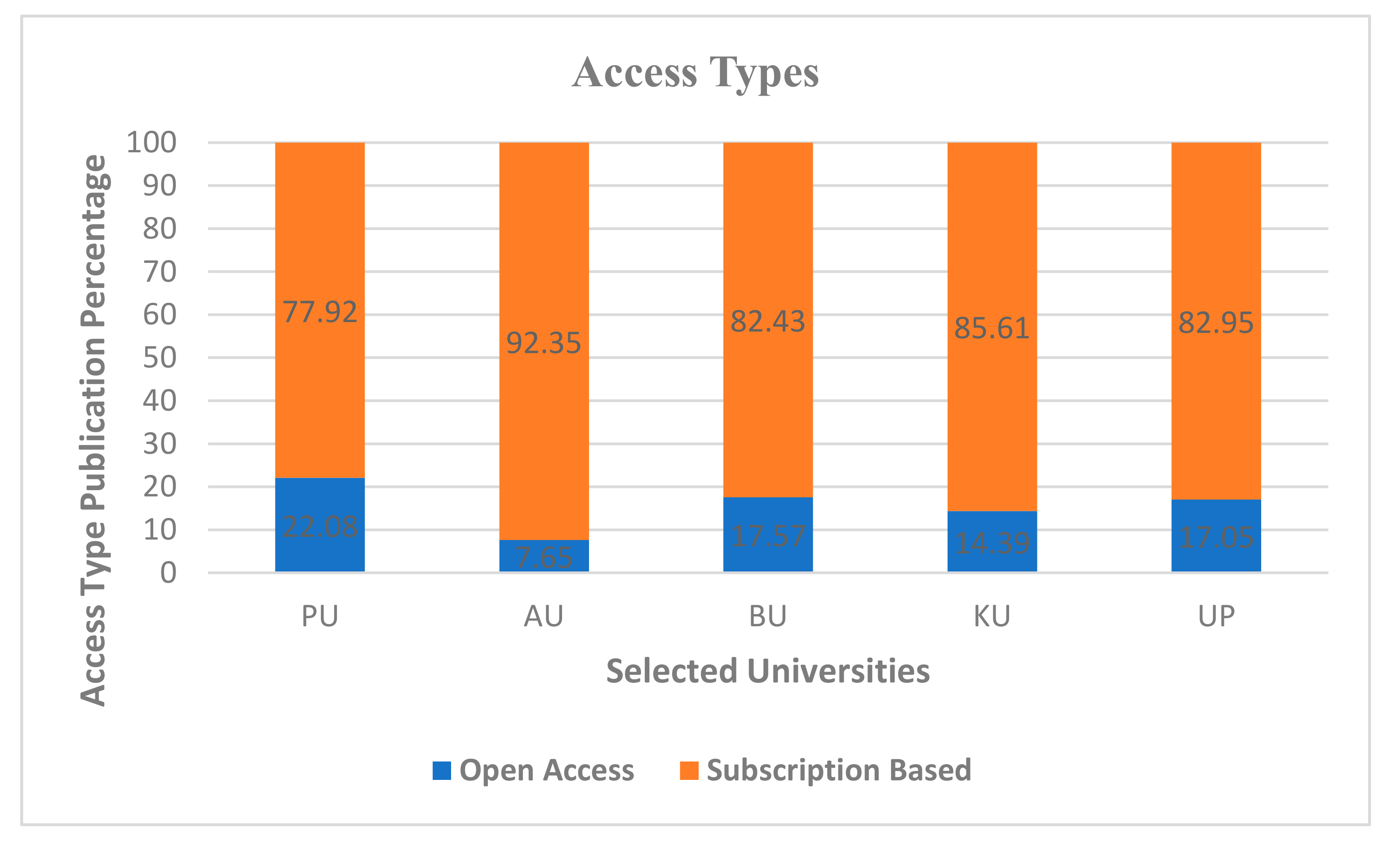


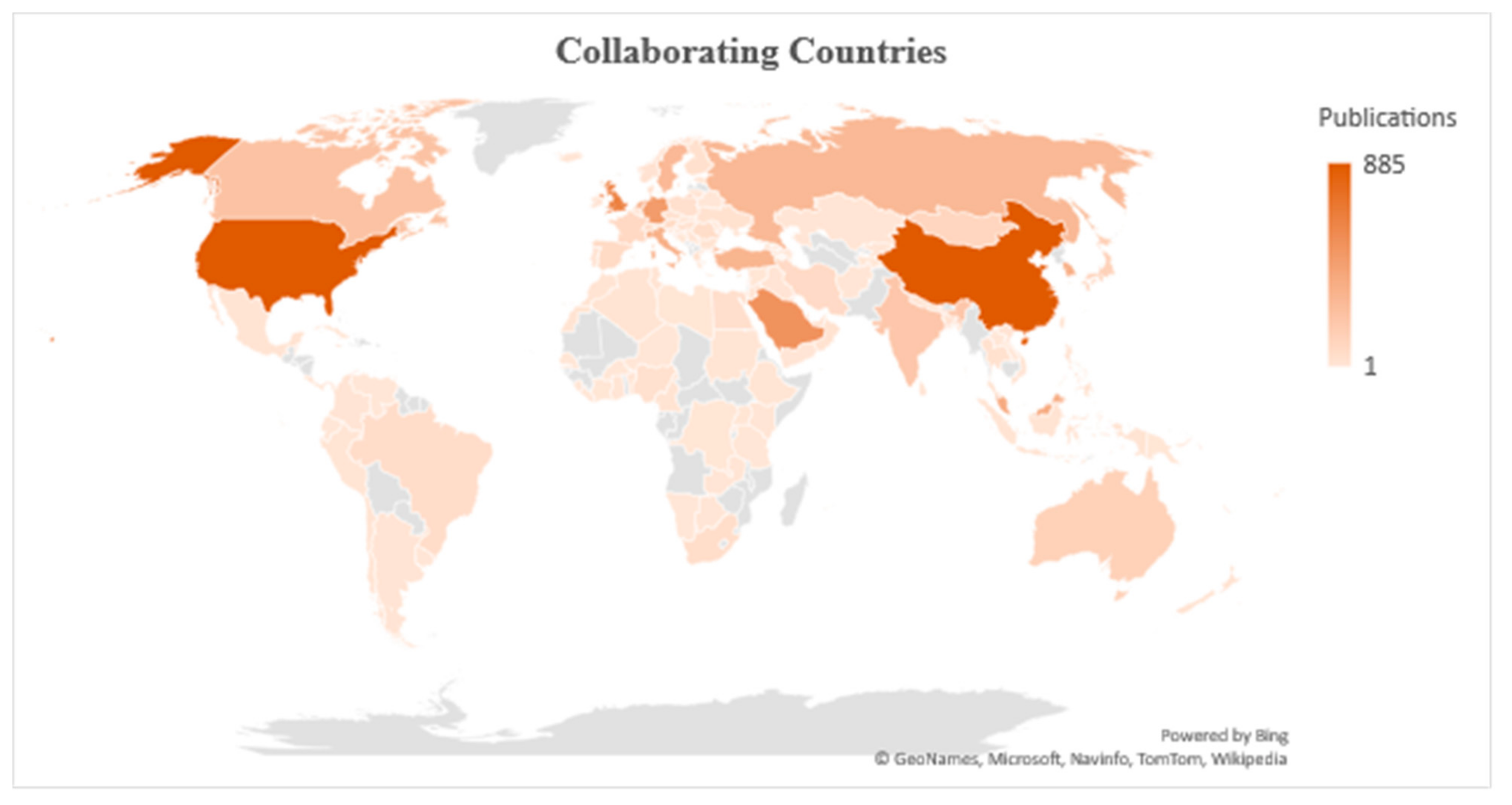
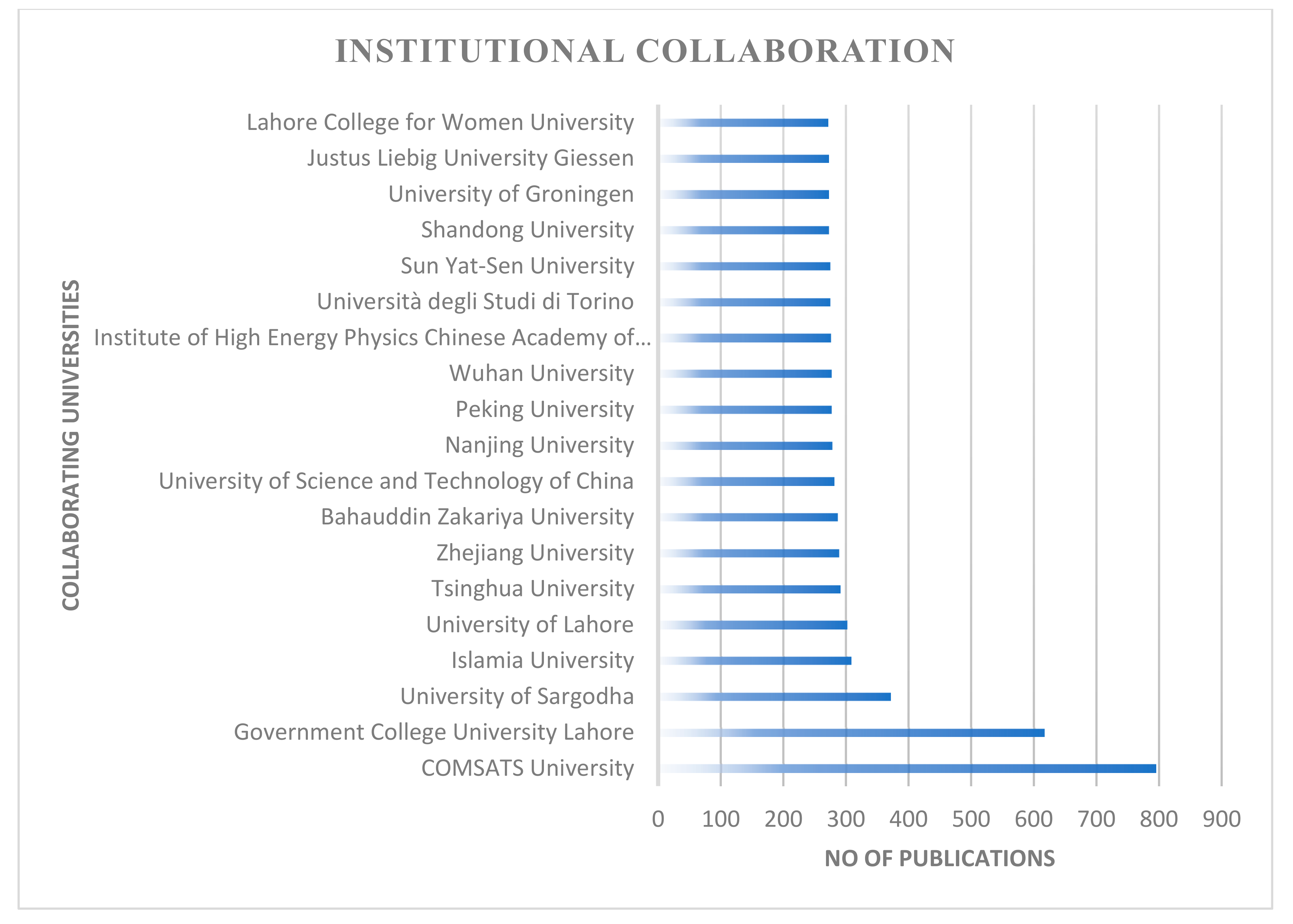
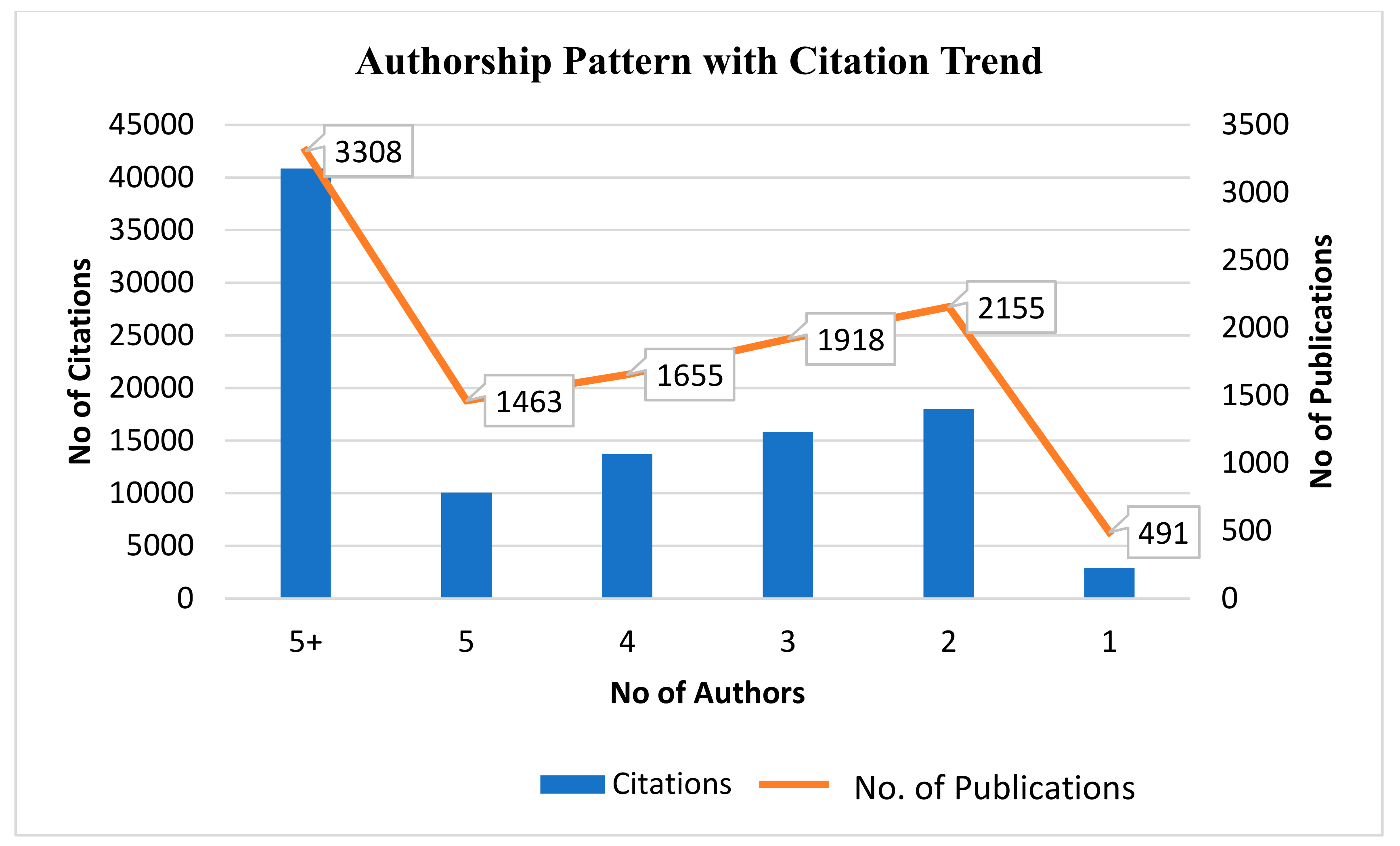
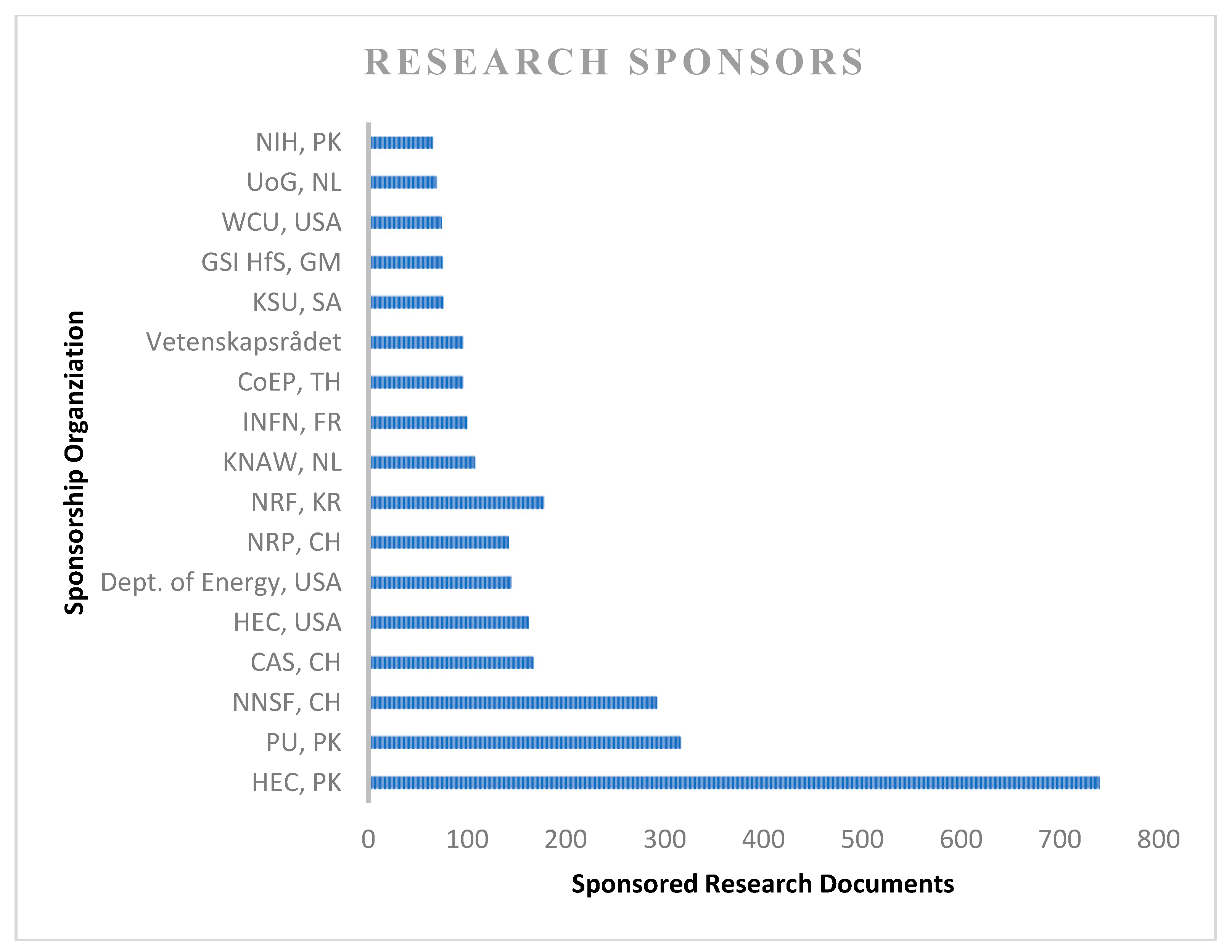
| Indicators | PU | AU | BU | UP | KU |
|---|---|---|---|---|---|
| Publications | 10,990 | 8248 | 1344 | 4823 | 10,154 |
| Citations | 101,349 | 79,013 | 10,571 | 49,014 | 100,375 |
| Avg. Citation/Document | 9.22 | 9.58 | 7.86 | 10.16 | 9.88 |
| Cited Documents | 8256 | 6129 | 1015 | 3770 | 8189 |
| % Cited Documents | 75.12 | 74.30 | 75.52 | 78.17 | 80.65 |
| Non-Cited Documents | 2734 | 2119 | 329 | 1053 | 1965 |
| % Non-Cited Documents | 24.88 | 25.70 | 24.48 | 21.83 | 19.35 |
| Max Citations to a Document | 3569 | 1575 | 284 | 1085 | 379 |
© 2020 by the authors. Licensee MDPI, Basel, Switzerland. This article is an open access article distributed under the terms and conditions of the Creative Commons Attribution (CC BY) license (http://creativecommons.org/licenses/by/4.0/).
Share and Cite
Ahmad, S.; Javed, Y.; Hussain Khahro, S.; Shahid, A. Research Contribution of the Oldest Seat of Higher Learning in Pakistan: A Bibliometric Analysis of University of the Punjab. Publications 2020, 8, 43. https://doi.org/10.3390/publications8030043
Ahmad S, Javed Y, Hussain Khahro S, Shahid A. Research Contribution of the Oldest Seat of Higher Learning in Pakistan: A Bibliometric Analysis of University of the Punjab. Publications. 2020; 8(3):43. https://doi.org/10.3390/publications8030043
Chicago/Turabian StyleAhmad, Shakil, Yasir Javed, Shabir Hussain Khahro, and Arslan Shahid. 2020. "Research Contribution of the Oldest Seat of Higher Learning in Pakistan: A Bibliometric Analysis of University of the Punjab" Publications 8, no. 3: 43. https://doi.org/10.3390/publications8030043
APA StyleAhmad, S., Javed, Y., Hussain Khahro, S., & Shahid, A. (2020). Research Contribution of the Oldest Seat of Higher Learning in Pakistan: A Bibliometric Analysis of University of the Punjab. Publications, 8(3), 43. https://doi.org/10.3390/publications8030043








